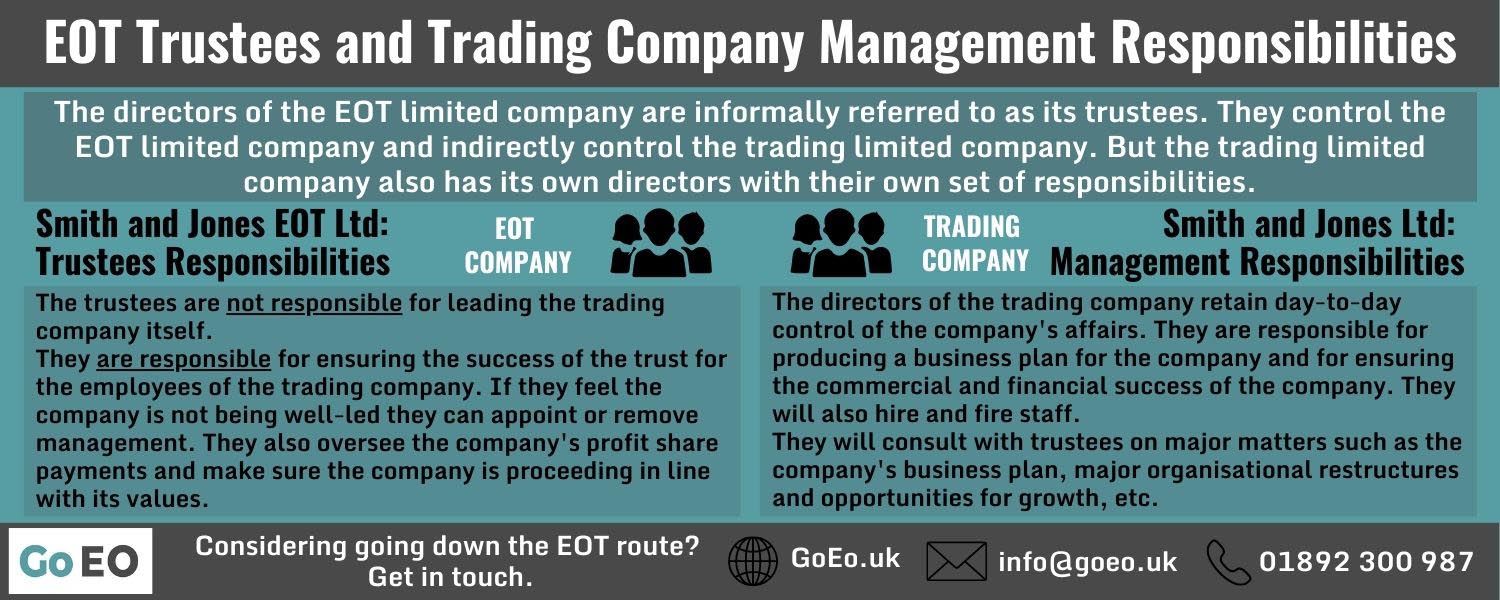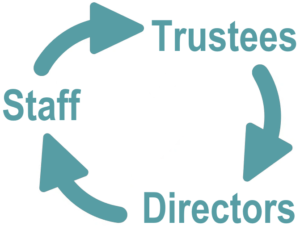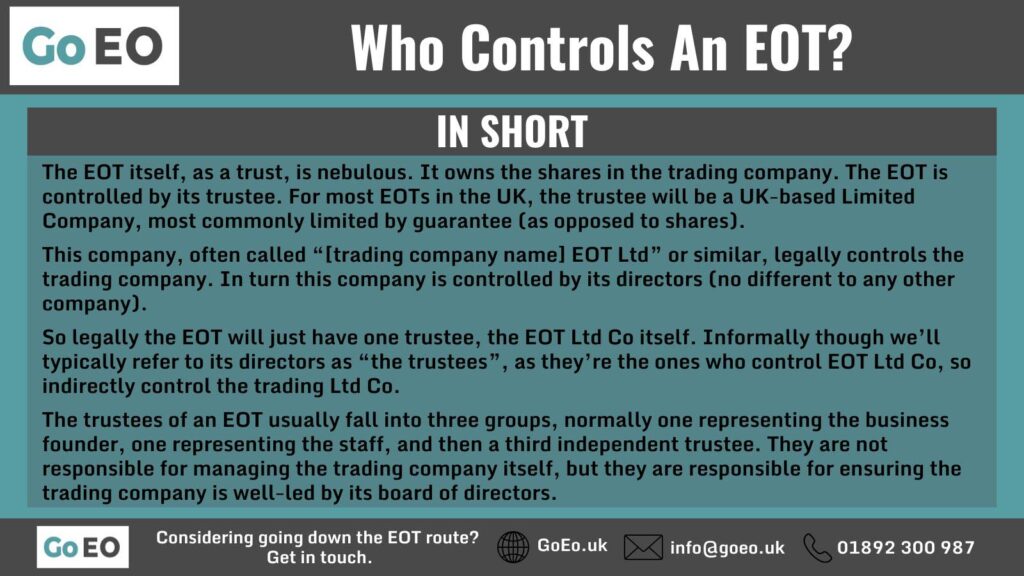It can take a little time to get your head around the structure of an Employee Ownership Trust (EOT).
Often this is due to some confusion between the roles and responsibilities of the EOT and the trading company itself.
They will typically be two separate entities but they are intricately linked.
Today we are going to take a closer look at the EOT and more specifically, who controls it.
Who Controls An EOT? In Short
The EOT itself, as a trust, is nebulous. It owns the shares in the trading company. The EOT is controlled by its trustee. For most EOTs in the UK, the trustee will be a UK-based Limited Company, most commonly limited by guarantee (as opposed to shares).
This company, often called “[trading company name] EOT Ltd” or similar, legally controls the trading company. In turn this company is controlled by its directors (no different to any other company).
So legally the EOT will just have one trustee, the EOT Ltd Co itself. Informally though we’ll typically refer to its directors as “the trustees”, as they’re the ones who control EOT Ltd Co, so indirectly control the trading Ltd Co.
The trustees of an EOT usually fall into three groups, normally one representing the business founder, one representing the staff, and then a third independent trustee. They are not responsible for managing the trading company itself, but they are responsible for ensuring the trading company is well-led by its board of directors.
EOT Management Structure: An Overview
The semantics of an EOT itself can be difficult to grasp initially.
An EOT is a trust, usually controlled by a limited company, established to oversee the trading company and ensure it is well-led.
But the EOT itself is led by its directors, of which there are normally three or more, and who are informally referred to as the ‘trustees’.
So it is these directors (or trustees as we shall refer to them going forward) that control the EOT.
Trustees and Their Control

But exactly what control do these trustees have?
It is important to remember that the trustees are not responsible for leading the trading company itself.
This responsibility falls, as it would usually, to the directors and management team of the trading company.
But the trustees are responsible for the assets of the EOT, and for ensuring the success of the trust on behalf of its beneficiaries, who are the employees of the trading company.
And if the trustees feel the trading company is not being well-led or managed efficiently, then that directly impacts the asset of the trust.
In a situation like this, the trustees could choose to appoint or remove directors of the trading company if they think it is needed.
Trustee Priorities

In addition to ensuring the company is well run, the trustees also have a number of other ongoing priorities, which include:
- Overseeing the company’s profit share payments and deciding how they are allocated between employees.
- Ensuring the company is proceeding in line with its values and business plan.
- Being involved in any major decisions that fall outside of the company’s business plan, for instance if there are acquisition opportunities for growth purposes or if the company is considering a major restructuring.
In short, if the trading company is progressing well, and in accordance with its business plan, the trustees will be less involved.
In the early days, following the formation of an EOT, the trustees will also play an important role in making sure that employees understand their involvement in the EOT, and, as such, with the business.
This could include ensuring they are aware they do not personally own a percentage of the business, that they are working for each other’s benefit not just their own, and that initially, it might take time to pay off the purchase price of the business to the owner.
So Who Are the Trustees of an EOT?

Now you know it is the trustees who control an EOT, and in effect have a big influence over the trading company itself, it begs another question.
Who are the trustees of the EOT?
Small employee-owned companies usually have three trustees, larger companies often have more.
However, no matter how many trustees the EOT has, they tend to come from three groups:
- Founder/Director Trustee
The founder of the business will often initially be a trustee, or appoint a trustee to represent them. Longer term someone else from the board of directors will be a trustee. - Employee Trustee
An employee will usually be appointed as a trustee to provide a voice for the staff. In larger companies there may be multiple employee trustees, with an employee council underneath them to involve more employees. - Independent Trustee
An independent trustee provides a balanced and (as the name might suggest) independent view, to ensure that the perspective of the directors and the employees are not under/overrepresented.
We go into this in more detail in our blog looking at the trustees of an EOT, but the way an EOT is structured also provides an alternative answer to the question of who controls it.
The Circle of Power
So technically the aforementioned trustees control the EOT, but in reality the EOT is also to an extent controlled by the employees of the trading company.
That is because the staff themselves can have a say over who represents them in the EOT.
If the employee trustee decides to step down or leaves the company then a new trustee will be needed and it will be up to the staff to decide who that is.
The newly elected employee trustee will then be part of the EOT and have a say on important matters related to the trading company.
So there is a circle of power in employee-owned companies that isn’t found in traditionally owned companies:

- Employees: Have the power to elect a trustee to the EOT.
- Trustees: Have the power to appoint or remove directors if seen as necessary.
- Directors: Have the power to hire and fire employees.
Then the circle starts all over again, so no one has ultimate control!
Summary

In short, an EOT is controlled by its directors, informally known as trustees.
The trustees aren’t responsible for the management of the trading company but are responsible for ensuring the success of the EOT for its employees.
Therefore if the trustees feel the trading company isn’t being well-led, they do have the power to appoint or remove management.
Any other major business decisions, especially those that deviate from the main business plan will also have to be approved by the trustees.
An EOT usually has trustees from three groups:
- The business owner/founder.
- The staff
- An independent trustee.
The range of priorities, challenges and responsibilities for trustees will vary from business to business, but the main goal will always be to ensure the management of the trading company is running the business sensibly and for the benefit of its employees.
